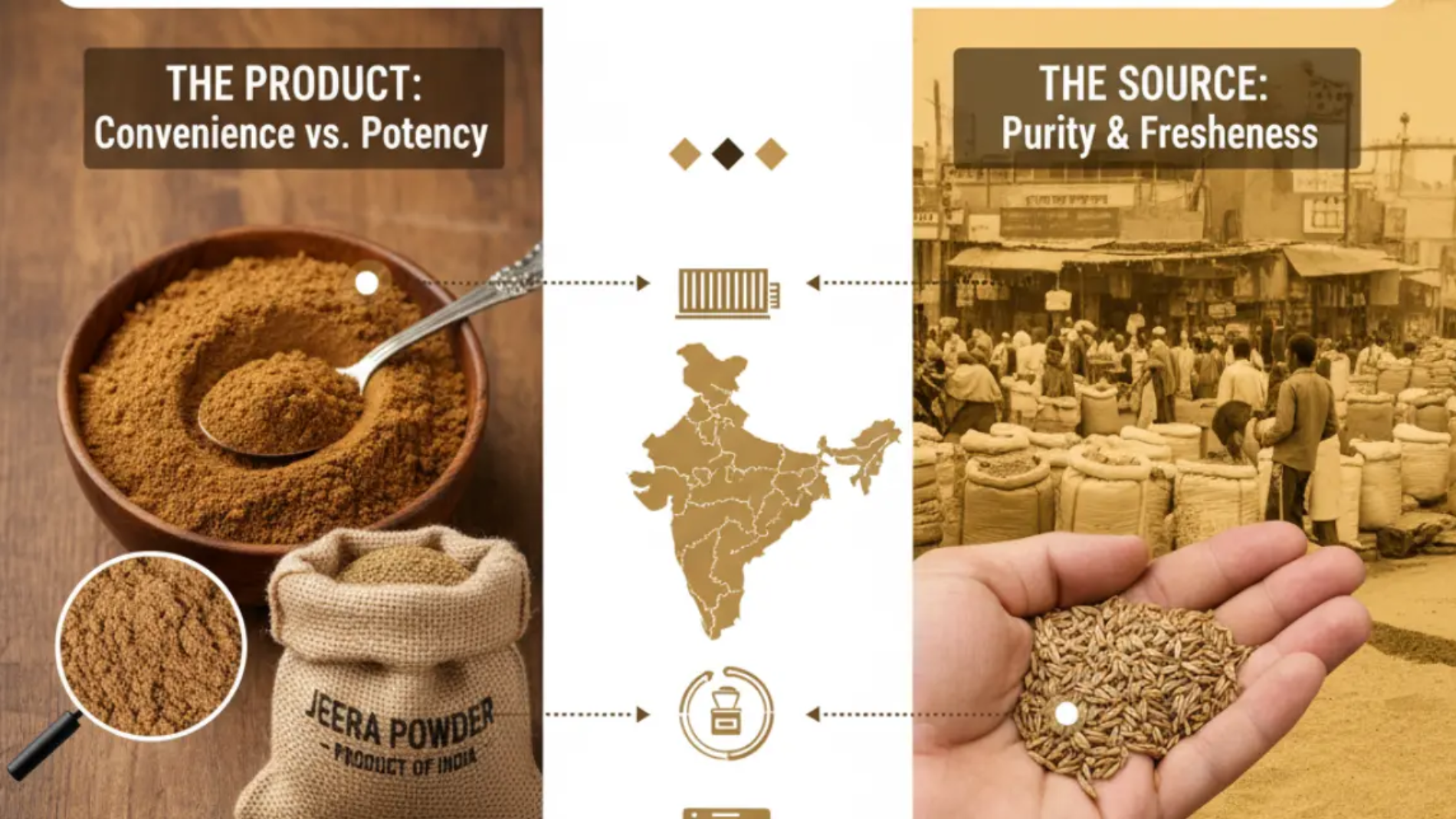Walk through any spice market in the world, and you will be greeted by a familiar, unmistakable aroma—warm, earthy, and slightly pungent. More often than not, that signature scent belongs to Cumin Powder. An indispensable ingredient in cuisines from Mexico to the Middle East and South Asia, this humble powder is a true global staple.
But for a food manufacturer, an importer, or a serious chef, understanding this food ingredient goes beyond its taste. What defines its quality? Where does the best cumin come from? And what are the critical differences between buying pre-ground powder and whole seeds? This guide will walk you through the essential details every professional buyer should know.
What is Cumin Powder? The Basics
Simply put, Cumin Powder, known widely as jeera powder in India, is the result of finely grinding dried cumin seeds. These seeds are the fruit of the Cuminum cyminum plant, a member of the parsley family. The grinding process releases the seed’s volatile oils, creating the intense, aromatic powder that is so prized in the culinary world.
The Origins: The Heart of Flavour in India
While cumin is used globally, its production is heavily concentrated. India stands as the world’s largest producer and exporter, and the quality of Indian cumin is the global benchmark. The primary growing regions are the arid, sunny states of Gujarat and Rajasthan.
At the heart of this trade is the bustling Unjha market in Gujarat, the world’s largest trading hub for cumin. The vast quantities and expertise concentrated here allow for the standardization of quality and grading, making it the epicenter for cumin exporters and international buyers.
Understanding the Grades: A Mark of Quality
Not all cumin is the same. For B2B buyers, specifying the grade is essential for ensuring consistency. While there are many local grades, the international market primarily focuses on purity:
Singapore Grade (99% Purity): This is the standard grade for many global markets, allowing for a maximum of 1% impurities.
Europe Grade (99.5% Purity): This is a premium grade with stricter requirements, often achieved through advanced Sortex cleaning, resulting in a cleaner, more uniform product.
A higher purity grade is a clear indicator of a more professional and quality-focused supply chain.
Spice Up Your Business with Authentic Indian Flavors
Import and Export Excellence from India!

The Indispensable Role of Cumin Powder in Food Production
Cumin Powder is a foundational component in countless commercial food products. Its ability to provide a consistent, savory depth of flavour makes it a staple in:
Spice Blends: It is a key ingredient in curry powder, garam masala, taco seasoning, and chili powder.
Savory Foods: It is used extensively in soups, stews, sauces, and marinades.
Ready-to-Eat Meals: It provides an authentic, earthy base note in packaged meals across many cuisines.
Snack Foods: It is used in seasonings for chips, crackers, and other savory snacks.
Powder vs. Seed: A Critical Consideration for Importers
While pre-ground Cumin Powder offers undeniable convenience, professional buyers must weigh this against the significant advantages of sourcing whole cumin seeds.
1. The Flavour Potency: The moment a cumin seed is ground, its volatile oils begin to dissipate into the air. This means that pre-ground powder, over time, loses its aromatic potency. Freshly ground cumin, made from whole seeds just before use, delivers a dramatically richer, more complex, and more powerful flavour.
2. The Shelf Life Advantage: Think of a whole cumin seed as a tiny, perfectly sealed natural container for its flavour. Whole seeds have a significantly longer shelf life, retaining their freshness for years if stored correctly. Powder, with its vastly increased surface area, is more susceptible to oxidation and moisture, and its quality degrades much faster. For an importer managing bulk inventory, the stability of whole seeds is a massive financial and quality advantage.
3. The Purity Guarantee: It is much easier to visually inspect and verify the quality of whole cumin seeds. While reputable suppliers provide pure powder, the powder format can, in lower-quality markets, be a vehicle for undeclared fillers. Sourcing whole seeds gives the buyer ultimate control over the purity of the final ground product.
Making the Smart Choice
Cumin Powder is an essential global spice. However, for food manufacturers and importers who prioritize maximum flavour, the longest possible shelf life, and absolute control over purity, the strategic choice is clear. While convenience has its place, the unparalleled quality that comes from freshly grinding whole seeds is the mark of a truly premium product. Sourcing high-grade Indian cumin seeds provides the foundation for this quality.
Frequently Asked Questions (FAQs)
1. What is the difference between cumin and jeera?
There is no difference. “Jeera” is the Hindi name for cumin. The terms are used interchangeably, with jeera powder being the same as Cumin Powder.
2. How can I tell if Cumin Powder is high quality?
High-quality powder will have a strong, warm, and earthy aroma. Its colour should be a uniform brownish-yellow. If it smells dusty or weak, it is likely old. The ultimate guarantee is a Certificate of Analysis (COA) from your supplier.
3. Why do many chefs and spice blenders prefer to buy whole cumin seeds?
They buy whole seeds and grind them in small batches to ensure maximum freshness and potency. The flavour and aroma of freshly ground cumin are significantly more intense than pre-ground powder that has been sitting on a shelf.
4. What are volatile oils in cumin?
Volatile oils are the natural aromatic compounds within the seed that are responsible for its distinct smell and taste. Grinding releases these oils, which is why freshly ground cumin is so fragrant.
5. Why is Indian cumin so popular?
Indian cumin is prized for its strong, consistent, and aromatic flavour profile. Furthermore, the massive scale of production in India ensures a reliable, year-round supply for the global market.
6. How long does Cumin Powder last compared to whole seeds?
Properly stored, whole cumin seeds can remain fresh for up to 3-4 years. Cumin Powder, on the other hand, starts losing its potency much faster and is best used within 6-12 months for optimal flavour.
7. What’s the difference between cumin powder and coriander powder?
They are two different spices. Cumin is earthy, warm, and pungent. Coriander is lighter, brighter, and has citrusy notes. They are often used together in spice blends but are not interchangeable.
8. Can I substitute whole seeds for powder in a recipe?
Yes. A general rule of thumb is that 1 teaspoon of whole cumin seeds is equivalent to about ¾ teaspoon of cumin powder, as the powder is more concentrated by volume. The seeds should be toasted and ground for best results.
About us
We bridge the gap between local producers and global markets, ensuring seamless trade facilitation with exceptional quality and reliability. We provide quick delivery services with customized packaging with all approval of International Certificates (Spices board India, MSME, IEC, fssai, FIEO, APEDA, EU certification, FDA and Many More)
Contact us
Shop No. 3, Ganesh Prestige Sr. No. 2/15, Near Laxmi Jewellers, Dhanakawadi, Pune – 411043, Maharashtra INDIA.
Call On
+91 9545205050
+91 9822422584



Leave A Comment